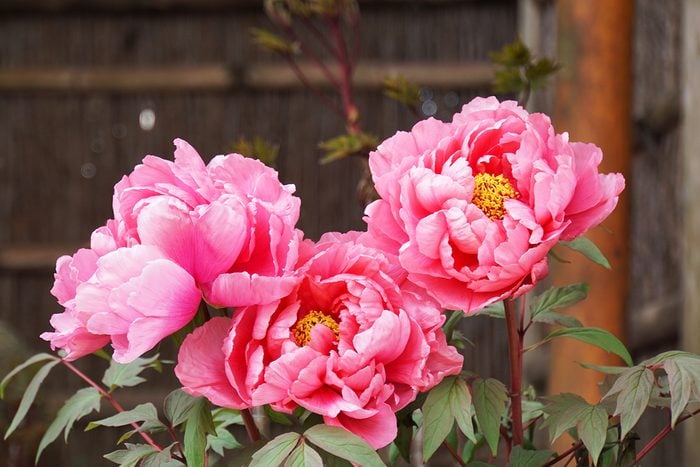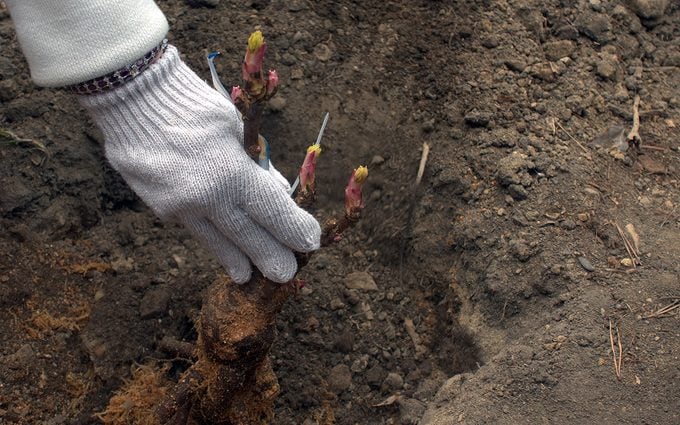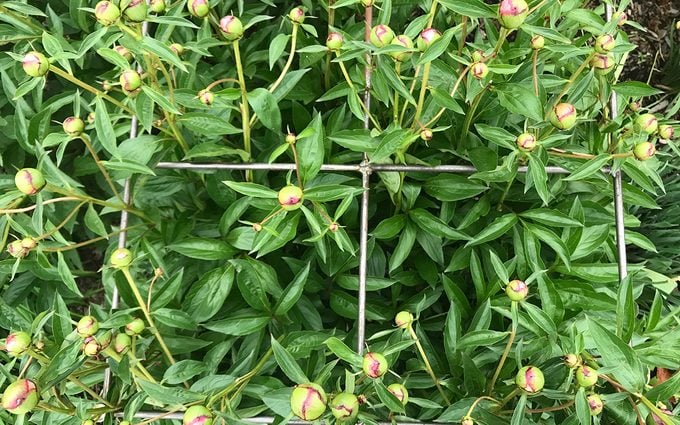How to Care for Peonies
Updated: Jun. 09, 2021

For stunning blooms that will be the envy of the neighborhood, take note of these pointers for peonies care.
Gorgeous, old-fashioned peonies with showy, full flowers will catch the eye of all who pass by. These perennials are so long-lived that they’re often handed down from one generation to the next. In addition to the eye-catching blooms in shades of pink, white, red, peach, yellow and lilac, many peony varieties are sweetly perfumed. They’re a popular choice for bouquets and cut flower arrangements.
Peonies care is important to understand, especially with new plantings. However, once they’re established, you’ll be rewarded with beautiful spring and summer flowers for decades.
Types of Peonies
The peonies with beautiful blooms in gardens and along fences are herbaceous peonies. They grow in zones 3-8 and can reach 2-4 feet in height. There are endless varieties within the different bloom categories. Referring to the type and number of petals, blooms can be single, Japanese, anemone, semi-double, full double and bomb.
Tree peonies are more shrub-like with woody stems that don’t die back in winter, and they grow best in zones 4-8. The most striking features of tree peonies are the height (from four to seven feet tall) and the enormous flowers.
Both herbaceous and tree peonies can live for several decades, which makes them one of the most worthwhile investments for your perennial garden. Peonies flower late spring through early summer, though some varieties have been bred to bloom later in the season.
Peonies are easy to grow and care for, as long as they have the right growing conditions and location.
9 Peonies Care Tips for a Successful Garden
Plant Your Peonies Carefully

Many perennial gardeners rest easy knowing if the first spot doesn’t work out, they can move the plants around. Peonies, however, can be fussy about being moved. Though you can divide and transplant them, doing so means you’ll have to wait a season or two for the blooms to resume. It’s best to plant them in the best location the first time you bring them home. The good news is that once peonies are established in their happy place, they will grow and bloom with little care for years. So do your planning now!
Add some edible plants to your landscape, too.
Choose the Right Location
Peonies need three things to thrive: sun, well-drained soil and good airflow around the plants. Choose a location in your landscape that gets 6 to 8 hours of full sunlight. The soil needs to be rich with organic matter, neutral to slightly acidic, and be able to drain well so there’ll be no standing water around the roots. Space peony plants about 4 feet apart, so they aren’t crowded. These factors also reduce the chance that powdery mildew or blights will affect the plants.
Other considerations: give your peonies some protection from strong wind, since they’re top-heavy when in bloom and can topple. Because peonies are heavy feeders, plant them away from trees and bushes that will compete for water and nutrients.
Know the Best Time to Plant
If you’re reading this in the springtime, don’t be too disappointed with this part: peonies have the best long-term success when they’re planted in the fall. The winter chill is beneficial for peonies, helping them set buds in the spring, and this is true for new plants, too. Plan to put them in the ground about 6 to 7 weeks before the ground freezes.
While you wait for fall to roll around, spend time planning out where your peonies will go, working compost into the soil and treating yourself to cut peonies from a local farmers market as you dream about your future flowers.
Dig a Large Enough Hole
Peony roots look gnarly and tough, but they’re actually easy to damage. Root damage will make it harder for your plant to get established, so handle them carefully. Look at your root and find the eyes, which are the little pointy nubs at the top where the stems will grow. (On tree peonies, look for the spot where the root and stem are grafted.) It’s critical that these go only 2 inches below the surface of the ground—any deeper and the plant won’t produce blooms.
Dig a hole twice as wide as the root or root ball and about 18 inches deep. Loosen the dirt around the inside of the hole. Then, build up a mound of compost-amended soil in the center of the planting hole. Your peony root will sit on top of this mound, so check that the height allows the eyes to sit only two inches below ground level. Set the root on the mound, and you can add a little granular fertilizer around the root as well. Carefully backfill the hole with soil, and then firm up the soil over the plant. Water this spot thoroughly.
Water Regularly to Establish Plants
Water your peonies well, a few inches every week, while at the same time checking that the soil is draining and the roots are not waterlogged. Other than water, your peonies won’t need much from you—except your patience in the first couple of seasons. It typically takes 2 to 3 years for peonies to bloom prolifically after planting, and this goes for transplants, too.
When your peonies do have flowers, deadhead the fading blooms to keep plants looking tidy and help the plant put energy into the other buds.
Invest in Metal Supports

Those big, luxurious blooms are heavy, which is why you so often see peony stems bent over right to the ground under the weight of the flowers, especially after it rains. Invest in some metal supports to place over your peonies when they’re first emerging so that the stems will grow up through. The support can be as simple as a three-legged single ring or a tomato cage, but since you’ll have your peonies for a lifetime it’s worth investing in attractive, heavy-duty supports. (Like these peony supports from Gardener’s Supply.)
More gardening supplies to invest in:
Know When to Cut Peonies Back
Peonies go into dormancy in the winter, so cut peonies back in the fall after the leaves have died. Use gardening shears to cut the stems close to the ground, then remove all the stems and leaves from the site. You can add a layer of mulch to help protect the sleeping peonies, but remove this mulch layer in the spring when they’re ready to emerge.
One note: only herbaceous peonies get cut back for the winter. The woody stems of tree peonies will stay above ground for the winter, and bloom on this wood in the spring.
Divide and Transplant Peonies When Dormant
After peonies have been in your garden a long time, the root clumps can get to be rather large. Many gardeners divide their peonies at this stage, to help reinvigorate the flowering potential. The best time to divide or transplant your peonies is as close to dormancy as possible: in very early spring or in the fall. As we mentioned, peonies can be fussy or downright unhappy about being moved, but you’ll have the best results if you don’t disturb the plants when they’re trying to grow and store up energy.
Dig up the peonies, and use a sharp knife to slice the root ball into sections with three to five eyes on each clump. Then, plant the clumps as outlined above. Remember that after dividing or transplanting, peonies will need a season or two to return to their full flowering potential.
Troubleshoot Peony Problems ASAP
Once peonies are established, they are a very low maintenance plant. However, there are some common problems that gardeners run into.
Black buds or stems
Blackening peony buds or stems are signs of a fungal disease called botrytis. This often shows up on peonies that are overwatered in poor draining soil, or if plants are crowded, which allows moisture to hang out. Cut away and remove affected buds and stems to keep botrytis from spreading.
In the fall when you cut peonies back, remove all the detritus so fungi won’t infect spring plants.
No flowers
If your peonies are getting enough light and water but not blooming, one possibility is that the peonies are new or have been transplanted. They will grow foliage but few or no flowers for the first couple of seasons, and this is normal as the plant gets established. After the second or third year, your peonies should have lots of flowers.
Another reason is if the peony root was planted too deep. When the eyes are too deep in the soil, the plants will only grow foliage. If you’ve had your peonies in the ground for several years and no flowers have appeared, try digging them up and replanting to set the eyes closer to the soil surface.
Peonies covered in ants

Well, it just wouldn’t be a peony without all those ants! Since ants are a big problem in the house, gardeners usually worry that ants are hurting their peonies. The fact is they’re harmless. Ants are attracted to the sweet droplets on the outside of the peony buds. They may actually be helping plants by eating aphids and other pests that are also drawn to this nectar. There’s no need to reach for the insecticide. Ants cause no harm and will move on as the blooms open.
Find more gardening solutions to common problems.



